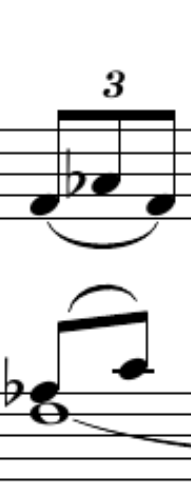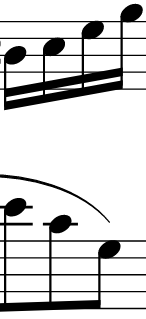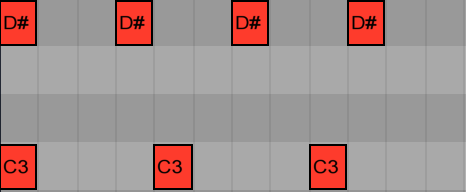Polyrhythms are rather easy in theory, but might turn out tricky when you actually try them out yourself. To get the basics straight, we suggest that you check this article out. In this article, we’ll show you the top 5 ways to practice polyrhythms. Are you ready to become better at polyrhythms?
Let’s take a look at a 3:2 polyrhythm example.

While you might think that looks complicated, it’s actually pretty simple. First, you have to isolate one rhythmic cell. Note that you don’t have to pay attention to the whole note for now.

Then, since 3 and 2 do not have any common factors other than 1, we have to multiply them.
2 x 3 =6
We then put this information in a grid:

Now, use your right hand and tap on any surface while counting until 6. Continue counting but skip the taps in-between and tap only on 1, 3, and 5. There goes your triplet.
Let’s do the same for the two eighth notes. First, tap and count until 6, and then tap only on 1 and 4 while still counting.
The tricky part is when you put them together. Look at the grid above, count until 6, and tap your right hand according to the top line and the left to the bottom. If you can, say ta when you tap the triplet, and then when you tap the two eighth notes to really hear the difference.
Let’s now have a look at another example in 4:3.

Again, let’s isolate a cell:

Now, you might wonder, “Why did we cut the sextuplet in half”? Simply because 8 sixteenth notes play during the sextuplet, and 8:6 is the same as 4:3.
Again, 4 and 3 do not have a common factor other than 1, so we multiply them.
4 x 3 = 12
We transfer it on a grid:

Now, all you have to do is repeat the steps from above, only counting until 12 this time!
Struggling to get it right? No worries, the metronome is here to help. Download our free metronome app (available for iOS and Android) and start slow, at 60 BPM. Set the metronome at 12/8 to have all the counts. All you have to do is look at the grid and tap on the beats marked with an x.
Alternatively, you can also assign one of the layers to the metronome: if it’s 2 eighth notes or a duplet, set the metronome at 2/4, if it’s 3 eighth notes or a triplet, set the metronome at 3/4, and so on. Perform the other layer on your instrument or by clapping your hands.
Remember that MIDI piano roll grid in your DAW? It’s actually a very useful tool when it comes to polyrhythms. Set the correct time signature and fill the grid the same way as above. For best results, use a drum kit to really hear the difference between the two contrasting rhythms. Here is an example of the 4:3 polyrhythm:

Try this only if you have mastered the steps above. Let’s go back to our 3:2 example. Tap the triplets with your right hand and the eighth notes with your left. Now add an accent on the first eighth of the triplet and keep tapping. Then add the accent on the second, and finally the third. Still easy?
Here is the ultimate challenge. Combine all three, so that the accent is on the first eighth of the first triplet, the second eighth of the second triplet, and the third eighth of the third triplet. Additionally, you can add accents for the left hand too.

Chances are, you aren’t going to remember when exactly fell your ta when you practiced those polyrhythms. A great memorizing technique involves the use of simple words. If there are two notes in a beat, you can use pa-sta, three spa-ghe-tti, four ma-ca-ro-ni, and five ca-la-ma-ra-ta. You will achieve proficiency in music as well as pasta types in time.
Maybe one of your school music teachers used the Takadimi system. It’s an alternative way to learn and pronounce rhythm using different syllables. Here is a guide, but we would only recommend using it if you have used Takadimi in the past.
Anja Drozdova is a Swiss-Russian musician and music teacher. She focuses on finding creative ways to engage students during piano and music theory lessons by using different mediums such as technology and visual arts. Anja also writes electronic pop music under the artist name Mlkshk. Her music is inspired by everyday life, scenes from childhood, and imaginary places, shapes and colors.
Soundbrenner is a company dedicated to helping musicians stay focused on what truly matters: their music. By creating innovative devices, such as Soundbrenner Pulse and Core, our goal is to deliver the best possible practice experience for musicians. Click here to find out more.
Got a question about Soundbrenner wearables? Reach out to us at [email protected], we’re happy to help!